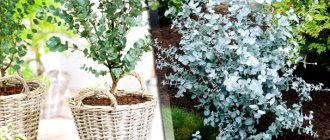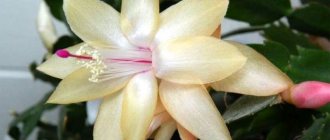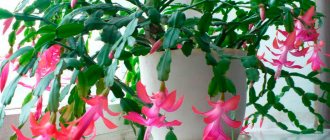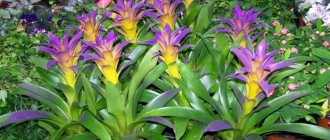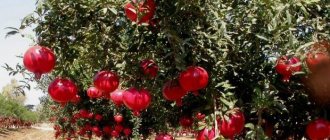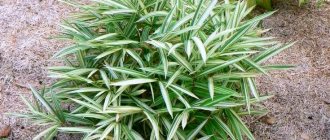Growing lemon eucalyptus from seeds
The culture can be propagated by cuttings and seed method. The permissible sowing time is quite long: from mid-February to the end of June. But planting from the third ten days of February to the second ten days of April is considered optimal.
For cultivation, you should use turf soil with sand in equal proportions, which must be prepared in advance. For sowing, use standard containers with drainage, such as ordinary flower pots, or cups for seedlings with stands.
Preparing to plant lemon eucalyptus seeds
Seeds are planted to a depth of 5 millimeters, 2-3 pieces per container. After sowing, it is recommended to cover the pots with plastic wrap or a bag - this will help retain moisture in the soil. Check the soil surface daily and moisten when dry.
Eucalyptus seeds germinate quite quickly, but provided that the room temperature is kept between 23-25 degrees Celsius. The first shoots can be noticed within a week after sowing, but pipping can take up to three months.
Eucalyptus seeds germinate quickly and seedlings need to be picked
This plant needs picking. It is performed when the first 2 true leaves appear. Seedlings are planted one at a time in a container with a diameter of 7 centimeters. Before planting, prepare the soil by mixing turf soil, humus and sand in a one to one ratio.
Varieties suitable for home cultivation
How to grow a lemon tree from a seed at home
There are many types of eucalyptus (more than 500), but only a few of them are suitable for growing as an ornamental crop. The most popular include:
- globular. It stands out for its beautiful, pyramidal crown and bluish-blue leaves, on the outside of which there is a silvery coating;
- Gunny. Young plants have round, gray-green leaves, which become oblong with a pointed tip as the tree matures;
- Blue baby. Belongs to the dwarf species of eucalyptus. Distinguished by small gray-blue petals;
- fig leaf. It stands out among other varieties due to its rounded small leaves;
- silver or ash. The main difference is the gray oval or round leaves;
- Populus is an ornamental eucalyptus that is capable of forming small berries.
Important! These varieties are not intended for planting in open ground; they can only be grown indoors.
There is also a very beautiful species, the rainbow eucalyptus, which has bark of various colors similar to a rainbow, but it is not suitable for growing as a houseplant.
Varieties of plants in pots on the windowsill
Flowering and fruiting of a eucalyptus tree
Flowering in eucalyptus trees begins from 2 to 10 years. Flowering usually occurs in late spring or early summer, but there are differences depending on the type of eucalyptus. The buds usually appear first, and then over the course of three months they begin to gradually open. They also experience fruit ripening. Ripening usually lasts one year, maybe a little longer, depending on the climate. Seeds ripen in the fruits. Seeds can be planted for ten years; they retain their viability for a very long time. There are cases when seeds are stored for forty to fifty years.
Caring for eucalyptus at home
This culture loves warmth and light, so you should think in advance about the location of the pots with seedlings. Until the plant gets stronger and actively develops, it is necessary to create the following conditions:
- temperature not less than 24 degrees Celsius;
- increased air humidity of at least 65% in winter, and 60% in summer.
To prevent the eucalyptus from getting sick, it is necessary to harden it.
To prevent the plant from getting sick, it is necessary to harden it. This can be done in warm weather, but it is important to avoid drafts. In winter, the permissible temperature for keeping the plant is up to 16 degrees Celsius.
Temperature
Eucalyptus is a houseplant, and for good growth it needs a certain temperature and humidity. In summer, the temperature should be maintained above +20 ºC, in winter it should be reduced and the tree should be kept cool.
Important! In spring and summer, you can take the pot with the plant to an open area.
Formed eucalyptus
Lighting
The culture loves light and this must be taken into account when placing pots. The best growing zone is south, east and southeast. The lack of sunlight can be compensated by using fluorescent lamps.
In summer it is useful to expose eucalyptus to sunlight, but it is important to be careful not to cause a burn. The plant should be accustomed to natural sunlight gradually.
Priming
The most favorable soil composition:
- humus – 1 part;
- turf soil - 1 part;
- river sand – 1 part.
You can use universal purchased soil.
Watering and air humidity
Watering eucalyptus during the period of active growth should be plentiful. In winter, the amount of water is reduced and the time between watering is increased. When caring for a plant, you should not go to extremes. It should be understood that both drying out of the soil and its excessive moisture are dangerous for it. Excessive watering can lead to root rot and subsequent death of the plant.
It is recommended to water eucalyptus with settled water at room temperature.
Lemon eucalyptus is a plant that needs constantly moist air, especially on hot sunny summer days. Eucalyptus reacts very poorly to spraying. The most optimal way to maintain humidity is to place the pot on a specially designed tray that has constantly moistened drainage.
Top dressing
The culture actively develops from spring to autumn, and winter is a dormant period. During this period, it is recommended to add organic matter and mineral fertilizers. Fertilizers are applied every 14-20 days, and stop in winter.
Soil and replanting
Indoor lemon eucalyptus at a young age requires annual replanting. Adult specimens are replanted every 2-3 years. Eucalyptus does not tolerate this procedure very well, so it is better to transplant it into a larger pot by transshipment, which will help avoid damage to the root soil.
When replanting plants over 3 years old, the roots are pruned. Garden varnish is used to lubricate the cuts.
The soil for lemon eucalyptus should be quite loose. The composition of the soil usually includes turf soil, peat, river sand and humus. Be sure to have good drainage at the bottom of the pot.
The transplant is done as follows:
- Eucalyptus is watered in advance to make it easier to remove from the old pot.
- Prepare a larger pot.
- A drainage about 5 cm thick is made at the bottom of the container, and a small layer of earth is poured on top.
- The tree is removed from the previous pot, lightly shaking off the old soil from the roots.
- Inspect the entire root system, cutting off all damaged and rotten roots.
- The cut areas are sprinkled with charcoal or activated carbon.
- The plant is placed vertically in the pot and soil is added.
- Water with warm purified water.
An overgrown plant needs a new, spacious pot so that the roots do not suffer due to cramped space. After transplanting or planting, the plant goes through an adaptation period, so it should be removed away from bright sunlight and not fertilized for one week.
Young eucalyptus trees need to be replanted annually, mature trees - once every two years. When replanting a tree, you do not need to deepen it too much.
Eucalyptus replanting
A young plant up to three years old is replanted annually, choosing a pot accordingly. For adult cultures, the interval between procedures increases to 3 years.
An adult eucalyptus plant is replanted every three years.
Eucalyptus does not like to be transplanted, so extreme care must be taken. The best way is to carefully transfer it into a larger pot without destroying the root ball of earth.
When replanting adult plants, prune broken, rotten, or infected roots. The cut areas are treated with garden pitch or a weak copper-containing solution. Drainage is placed at the bottom of the container prepared for planting, and it is filled with loose soil, in the same composition as when planting the plant.
Spraying
When caring for eucalyptus at home, you do not need to spray the plant.
Trimming
When growing eucalyptus at home, it is important to control the growth of shoots. For these purposes, the main shoot is pruned in the spring, removing the main growth point at a height of one meter. After the procedure, the plant produces lush side shoots, and pinching should be done to form them.
Do I need to change the water in cuttings?
There is no need to change the water under the cuttings, but only add it if necessary. It is better to put 1 or 2-3 cuttings per 1 glass or jar. Almost all of the cuttings die in large numbers. Place a piece of charcoal or activated charcoal in the water; it will inhibit putrefactive processes.
Interesting materials:
How to download a game to a laptop? How to replace the battery on an Acer laptop? How to replace the battery in a Lenovo laptop? How to replace ssd in laptop? How to Password Protect a Lenovo Laptop? How to password protect a laptop? How to record audio on a laptop? How to record voice on a laptop? How to record a voice message on a laptop? How to record sound on a laptop?
Possible problems during cultivation
Improper care can cause disease and even death of the plant. If the process of caring for eucalyptus is disrupted, the following problems may appear:
- in case of insufficient lighting, the stems will become very tall, the leaves will decrease in size and change their color to a less saturated color. To solve the problem, it is necessary to move the flower to a more illuminated place or organize additional lighting, especially in winter, when daylight hours are short. It is also worth doing in the summer in cloudy weather;
- If there is insufficient watering, the leaves on the eucalyptus will dry out and fall off. In this case, it is necessary to adjust the watering regime;
- direct sunlight on the leaves and insufficient watering can cause burns. During the midday heat, it is worth shading eucalyptus and moisturizing it in a timely manner;
- Excessive moisture can lead to stagnation of water in the soil, rotting of the root system, softness and falling leaves.
Diseases and pests
Like most essential oil plants, the indoor eucalyptus flower is almost not attacked by harmful insects. It is very rare to find spider mites or any type of aphid on it. In this case, isolate the indoor eucalyptus in a pot from the rest of the indoor flowers and apply the insecticide in two or three doses with an interval of several days.
Any changes in the appearance of the Eucalyptus indoor plant usually indicate discomfort experienced:
- Due to lack of light, the shoots become elongated, and the leaves become smaller and turn pale.
- Withering and falling leaves indicate a lack of moisture; the volume or frequency of watering should be increased.
- Spots on the leaves may indicate sunburn; in the summer months, the plant should be slightly shaded during the daytime.
- When the earthen ball becomes waterlogged, the roots begin to rot and the leaves lose their original elasticity.
Thanks to its antiseptic properties, eucalyptus is not prone to diseases and pest attacks.
However, improper care can lead to the appearance of uninvited guests in the form of scale insects and spider mites. If insects are found, remove them with a damp sponge and treat the plant with insecticides.
Diseases and pests
Due to the high content of phytoncides, lemon eucalyptus is highly resistant to various types of diseases. Also, because of the smell, many pests avoid it. But if the care rules are not followed, spider mites or scale insects may appear. You can fight them with a damp sponge dipped in soapy water. If such actions do not lead to anything, you need to treat the plant with insecticides.
Lemon eucalyptus is a fragrant evergreen that is great for indoor growing and requires little care. It is easy to grow eucalyptus at home, because the rules of care are extremely simple. This flower can create a pleasant aroma in the room and purify the air, as well as quickly cure winter colds.
Description of eucalyptus
The plant in nature can reach a height of more than 80 meters, and one of the tallest species is the regal eucalyptus. But in indoor cultivation, the height of the tree rarely exceeds 2-3 meters, since its growth is successfully controlled by pruning and the size of the pot.
Exotics can be grown either as a tree or as a low bush.
Home flower eucalyptus
The flowers are solitary, axillary on short petioles or collected in inflorescences of 5-7 flowers. Instead of petals, the flowers produce numerous fuzzy stamens, which can be white, cream, golden yellow, pink, orange or red.
Garden decorative forms are distinguished by large flowers and abundant flowering.
Eucalyptus blossom
As the plant grows, three phases of leaf development can be seen: juvenile (young), intermediate and adult.
Young leaves are usually very different in shape from mature ones, which is why it was previously assumed that these were different crops.
Some species retain juvenile foliage throughout their lives or only for several years, while in others the transition from one phase to another is almost imperceptible.
Such leaves are round, heart-shaped, ovoid in shape, often similar to gray or green coins.
Mature leaves are larger, sickle-shaped, lanceolate, less often rounded, often green, but may be bluish.
Like other members of the myrtle family, eucalyptus leaves secrete essential oil, which is a characteristic feature of the genus. Eucalyptus under natural conditions begins to bloom only after reaching ten years of age.
How to propagate yourself
You can grow lemon eucalyptus from seeds, as well as by rooting apical cuttings.
Propagation by seeds
Reproduction is not difficult; it is sown in February-March. It is advisable to use soil heating if you have cold window sills, if the windows are plastic and there is no breeze anywhere, just place the bowl on the windowsill.
Seeds are sown to a depth of no more than 0.5 cm. Containers for germination should have drainage holes to drain excess moisture. After sowing, the containers are covered with a cover glass or plastic film to maintain optimal humidity.
The substrate for eucalyptus should not be too nutritious, neutral or slightly acidic, and may contain up to a third of peat. The best option is a mixture of equal parts clay-turf and compost soil with the addition of a small amount of river sand.
Until the first seedlings appear, it is necessary to periodically moisten the soil surface with a spray bottle and monitor compliance with the temperature regime.
With the emergence of seedlings, it is advisable to organize additional lighting so that the total duration of daylight hours is at least 12 hours a day. To avoid burns, seedlings should be protected from direct sunlight.
When the seedlings develop a pair of true leaves, they are planted in individual pots with a diameter of about 10 cm. A layer of drainage (expanded clay, tiles) must be laid at the bottom of the flowerpot. For young plants, it is recommended to use more nutritious soil and increase the percentage of sand, for example, by preparing a mixture of turf, humus soil, peat and sand in equal volumetric proportions.
Eucalyptus seeds are widely available for sale - from Gavrish and others, ask at flower shops. Moreover, lemon eucalyptus is no longer eucalyptus, but corimbia, but the seeds are still sold under the old name.
Germination of seeds
How to grow lemon eucalyptus using seeds:
- Place a drainage layer on the bottom of the planting container and soil on top.
- Pour lemon eucalyptus seeds Ozone, lightly pressing them into the ground, water with warm water.
- Cover the container with glass or film and place in a warm place for germination.
- Every day, plantings need to be ventilated, removing the cover and removing accumulated condensation.
- The first shoots can be seen after 7-10 days. When the first shoots hatch, the cover must be removed.
- When 3-4 true leaves appear, pick them out in separate small pots.
- When the young plants grow to a height of 15-20 cm, transplant them into a large pot.
Grown seedling
Rooting cuttings
Step-by-step process of rooting cuttings:
- From an adult plant, several young shoots 10-12 cm long are cut off, and all side leaves are removed.
- The cut is treated with a root growth stimulator.
- The sprouts are planted in prepared soil.
- Cover with film and place in a warm place.
- Rooting will take 3-4 weeks.
- When the cutting takes small roots, it is transplanted to a permanent place.
Eucalyptus wood physical and mechanical characteristics
Fig tree or fig tree how to grow at home
Eucalyptus wood belongs to the disseminated vascular species. All types of eucalyptus have light, sometimes light yellow, narrow sapwood; the core is brown, in completely different shades - pink, yellow, red, brown, orange. The kernels of eucalyptus versicolor, eucalyptus jarrah and eucalyptus mahogany are pink or bright red when young, but over time the kernels turn brown and become deep red. Because of this, in Australia, eucalyptus species of the mentioned species are called “redwood trees.”
The annual layers are faintly visible, only in a cross section. Eucalyptus wood is small-vascular, with the vessels filled with core substances and tills of different colors - from red-brown to yellow-brown. The medullary rays are uniform, numerous, and almost invisible to the naked eye.
Among the defects, eucalyptus wood occasionally exhibits curling and resin pockets in the form of veins.
In eucalyptus species that are valuable for woodworking, the density of dry wood ranges from 700 to 900 kg/cubic meter. Such characteristics of eucalyptus wood as strength and high biostability allow it to be used for open-air structures.
Mahogany eucalyptus wood - "mahogany"
When it comes to drying wood, eucalyptus is quite inconvenient. Eucalyptus wood is a highly drying species that is prone to warping and cracking when dried. However, when dried, this material retains its shape and size for many years. The older the eucalyptus is, the more it dries out, and plantation trees dry out less than those grown in natural conditions.
Another property of eucalyptus wood is its high strength. Thus, the static hardness of the surface of eucalyptus wood is 60-90 N/mm2.
Mechanical processing of eucalyptus wood does not cause any particular problems. Difficulties in processing this material are associated with the possible curliness and hardness of the wood. However, after sanding and polishing the result is always good. Eucalyptus holds fastenings well, bends and sticks. The core is very difficult to saturate with antiseptics, but in general, eucalyptus wood accepts varnishes, paints and stains well.
Eucalyptus wood: application
Thanks to the rapid growth of the eucalyptus tree, its wood has become widespread throughout the world as a source of biofuel, raw material for the pulp and paper industry (branches), and as a source of beautiful and valuable wood. Of course, eucalyptus wood is used mainly in Australia. In our latitudes you can find eucalyptus parquet - very strong and durable, eucalyptus veneer, eucalyptus tool handles, etc.
Eucalyptus wood chair
In Australia, eucalyptus wood is used to make parts for ships, telegraph poles, hydraulic structures and wherever there is a need for wood that is highly resistant to external factors.
But do not forget that eucalyptus wood is not only strong, but also beautiful. Thanks to polishing, this material can acquire a dark red, brown or gray tint. In their homeland, eucalyptus wood is used to make luxury garden furniture and is used for interior decoration.
Tatyana Kuzmenko, member of the editorial board of the online publication “AtmWood. Wood-Industrial Bulletin"
How useful was the information for you?
| Copyright atmwood.com.ua. Copying of material is permitted provided a hyperlink to the source is provided. |
Beneficial properties of indoor eucalyptus
Eucalyptus is a home plant that is often used to treat abscesses, furunculosis, purulent mastitis and various ulcers. Decoctions of eucalyptus leaves can be used for inhalation for acute respiratory infections and gargling for throat diseases and various problems in the oral cavity.
As mentioned earlier, eucalyptus contains an essential oil, the main constituent of which is cineole (eucalyptol). Oil, tinctures and infusions are prepared from the plant, which have bactericidal, antiseptic and antiviral effects.
Phytoncides released by eucalyptus help clean the air from pathogenic bacteria and microbes. In order to effectively clean the room, it is enough to place one tree in the room.
By rubbing a few eucalyptus leaves in your hands and inhaling the aroma, you can prevent colds. It should be taken into account that chewing the leaves and eating them can cause poisoning.
The uniqueness of the plant also lies in the fact that it is able to repel annoying insects such as flies and mosquitoes.
The leaves contain essential oil that has powerful antibacterial and antiviral properties. The leaves of the plant are used to prepare oils, infusions and alcohol tinctures.
Note! The plant will only be beneficial if you apply eucalyptus leaves and products prepared from them externally in the form of lotions, ointments or rinses. Ingestion may cause poisoning.
Uses of lemon eucalyptus
Oils contained in large quantities in the foliage of the plant are successfully used in medicine and cosmetology. It has disinfectant, astringent and bactericidal properties.
Up to 3% of essential oils are contained even in the dried leaves of the plant, which is why they are added to teas. For medicinal purposes, eucalyptus leaves are used to prepare decoctions and infusions.
Lemon eucalyptus essential oil has disinfectant, astringent and bactericidal properties.
Lemon eucalyptus oils alleviate pain in respiratory diseases, so they are added to inhalation products. Preparations containing essential oils are used to treat cervical erosion, herpes, and fungi.
Substances contained in plant fiber have high disinfecting properties. Medicines based on eucalyptus are used to relieve pain from lumbago, rheumatism, and neuralgia.
Due to its deodorizing properties, the oil is used in the manufacture of flavoring sachets. Also, the aroma, pleasant to human perception, is destructive to insects, so eucalyptus oil is used as a means to combat ants, mosquitoes and other sucking pests.
Meaning
As was said a little earlier, wood is very dense, so it is used for the construction of ships, sleepers, and can also be used for making paper. It is the wood that is used to make paper. Eucalyptus trees are also used for medicinal purposes. For this, only three types of trees are used: ball, ash and twig. It is known that Spain produces liqueur, which is usually used to prevent fever.
Eucalyptus (Eucalýptus) is a genus of plants belonging to shrubs and trees that belong to the Myrtaceae . Eucalyptus is native to Australia and the island of Tasmania, but due to its numerous beneficial properties it was introduced and began to be cultivated in many countries.
Eucalyptus got its name thanks to the famous French botanist Charles Louis Léritier de Brutel, who decided to combine two Greek words: “good, good,” pronounced “eu” and “hide,” which corresponded to “calypto.” This desire, unusual at first glance, is easily explained by the plant’s ability to hide its flower buds under the cups of leaves.
Eucalyptus is capable of releasing phytoncides into the air, which kill pathogenic bacteria and viruses, fungi, its foliage contains a large amount of essential oil, which is now successfully extracted and is widely used, and eucalyptus has been planted in many countries with this problem for its ability to drain swampy areas, After all, it is capable of drawing in up to 300 liters of water in just one day! In some areas of Australia, the aborigines believed that even one drop of eucalyptus oil could protect an entire home and all the people in it from evil unclean spirits. Thanks to all this and many other beneficial properties, eucalyptus was nicknamed the “wonderful tree.”
Read also: Shelf life of Turkish baklava
Eucalyptus has a very amazing ability to turn the surfaces of its leaves towards the sun with its ribs, thereby reducing the area of moisture evaporation, which is why the tree survives in hot, arid climates. This feature was also noticed by European colonists in the 18th century, who, having visited eucalyptus forests for a long time, could not understand why such huge trees did not cast an appropriate shadow. The great writer Jules Verne also wrote about this in his work “The Children of Captain Grant.”
In nature, this miracle tree can reach a height of up to a 50-story building, which is no less than 100 m in height, but at home, eucalyptus reaches only 2 m, then they try to limit its growth.
Medicinal properties
Shallot variety description, photo, cultivation and care photo
People have long noticed that it is very easy to breathe in eucalyptus forests. This is due to the fact that eucalyptus leaves emit volatile phytoncides, a kind of volatile antibiotics that consist of organic substances with a strong antimicrobial effect. Phytoncides secreted by the leaves have a beneficial effect primarily on the respiratory system, they give people vigor and health. It was experimentally found that the main components with healing properties are the essential oils contained in the leaves and young shoots. These medicinal properties have been actively used and now eucalyptus oil is used in various medications such as pectusin, ingalipt, efkamon, ingacamf, as well as various aerosols and cough tablets. In addition, the leaves are prepared and sold in pharmacies for preparing tinctures and decoctions at home. There is probably no person who has not experienced the healing properties of eucalyptus inhalation for colds.
Quite often, eucalyptus brooms are used in baths for colds. This is a very effective remedy that helps very often in one go. If you have a sore throat or runny nose, just hold a steamed broom to your face and breathe through your nose for 4-5 minutes. It is not very convenient to quilt with such a broom, the leaves are long and the branches are thin. It is better to weave eucalyptus branches into a birch or oak broom.
Although in practice it has been proven that eucalyptus preparations have virtually no side effects or contraindications, in some cases allergic reactions or individual hypersensitivity may occur. Very rarely, when used externally, skin irritation may occur.
Therefore, before starting treatment, it is better to check individual sensitivity to this remedy. In addition, it is not advisable to use eucalyptus preparations orally for children under 2 years of age, as well as for adults with impaired renal and liver function, bronchial asthma, and bronchospasm. It is better to refrain from using them for children with whooping cough.
During pregnancy, these drugs should be used with extreme caution. It is advisable to consult an aromatherapist first.
Eucalyptus essential oils are very widely used in the perfume industry. They contain aromatic substances such as citronellal, limonene and geraniol, which have very pleasant odors. With their help, persistent aromas of rose, lemon and many others are easily reproduced. These cosmetics are absolutely harmless and are constantly very popular. Detergents: soaps, scrubs, shampoos, gels with eucalyptus extract are an excellent remedy for many scalp problems. And shampoo-creams with a detox effect practically cleanse the hair of any impurities, including tobacco smoke.
You can often hear the question: Is it possible to grow eucalyptus at home? Why not?
Eucalyptus trees reproduce by seeds, which are naturally carried by the wind. But for many years they have been grown not just anywhere, but where people need it. These are mainly resort areas. And not only in Australia, but in many countries around the world. Artificially planted eucalyptus groves create an excellent healing environment. And coupled with sea air, staying in such places provides maximum health benefits for vacationers. Such groves can be successfully used for other purposes. For example, several such artificial forests were planted in Israel to protect against frequent artillery shelling from Palestine. They grew very quickly and became a real green protective wall.
Well, at home in our climate zone, eucalyptus trees are grown mainly in winter gardens, or in extreme cases, just in a large pot like any other house plants. Usually in any flower shops you can buy either seeds or ready-made seedlings. By transplanting them into flowerpots, you can create a real paradise with a healing twist in your apartment or house.
Thanks to the released phytoncides, your home will always have the purest healing air, and you will always have fresh eucalyptus leaves on hand, which can be useful for rinsing or inhalation. In addition, neither flies nor ants can tolerate the smell of eucalyptus. Eucalyptus growing in the house does not require special care, and it looks quite nice.
Features of care
Care at home consists of maintaining the desired temperature, timely watering, and forming a bush. Eucalyptus is a hardy plant that can withstand light frosts without significant damage. But it is still better to keep the flower at a temperature of 20-25 °C in summer, and at 12-16 °C in winter. The tree needs fresh air, but in winter, when ventilating, protect it from cold drafts.
If you do not trim the shoots, the tree will grow too tall. To form a lush crown, annual spring pruning is necessary. During the procedure, shorten the main trunk to the required height. After pruning, the plant produces young shoots, forming a lush bush. These fresh shoots also need to be pinched so that young shoots form on them.
This way you will form a crown of the shape you need. An adult plant needs root pruning during replanting. This is necessary to limit the extension of the trunk in height. Root pruning is used to create a eucalyptus bonsai.
Need for watering and fertilizing
Requirements for soil moisture levels depend on the time of year. During the warm season, make sure that the soil is always moist, but avoid excessive watering. In winter, water eucalyptus when the top layer of soil has dried well. During the period of active growth, the flower needs additional feeding with complex fertilizers twice a month. In winter, during the dormant period, eucalyptus does not need fertilizing.
Pests and diseases
Thanks to the presence of phytoncides, eucalyptus is resistant to diseases; most insect pests avoid it. If not properly cared for, you may notice the appearance of spider mites and scale insects. Use a wet sponge dipped in soapy water to remove insects. If this does not help, treat the flower with insecticides.
Reproduction methods
There are two methods used to grow eucalyptus - cuttings and seeds.
- From an adult plant, cut several young shoots 7-10 cm long.
- Treat the cut with a root formation stimulator.
- Remove some of the side leaves.
- Plant the cuttings in a prepared pot, in which a layer of drainage and soil are poured.
- Create greenhouse conditions by covering the cuttings with transparent film.
Keep pots in a warm place. Cuttings take a long time to take root, reluctantly; not all of them take root; it is easier to grow a flower from seeds.
More often, gardeners grow eucalyptus from seeds, which can be purchased at a flower shop.
Eucalyptus propagation by seeds:
- Place drainage at the bottom of the container and a layer of soil on top.
- Sprinkle the seeds, lightly press them into the soil, and moisten them with warm water.
- Cover the container with transparent film and keep it at a temperature of 22-25 °C.
- Remove the film daily to ventilate and remove condensation.
- The first shoots will appear in a week, the germination rate of eucalyptus seeds is high.
- After the shoots emerge, remove the film, and when 3-4 true leaves appear, plant them in separate containers.
When the seedling grows to 20 cm in height, transplant it to a permanent place.
When and how does it bloom
In its natural habitat, eucalyptus blooms in spring and summer with small snow-white flowers with a huge number of stamens, collected in umbrella-shaped inflorescences. Indoor lemon eucalyptus blooms very rarely at home.
Eucalyptus blooming with white flowers
Description and characteristics of the plant
Lemon eucalyptus (Eucalyptus Citriodora) is an amazing evergreen tree of the Myrtaceae family, which is considered to be native to Eastern Australia. Prefers to grow in warm climates. Under natural growing conditions it can reach 100 m in height. When kept indoors, the height of the plant can be easily adjusted with timely pruning and pinching. The leaves are quite dense, arranged in a spiral on the stems. They have an oval-lanceolate shape, reach 16 cm in length, and no more than 2 cm in width.
Indoor lemon eucalyptus
The bark of a eucalyptus tree is white with red-brown, sometimes orange, streaks. There are small growths at the bottom of the trunk.
Eucalyptus flower in a pot, Blue Baby variety
